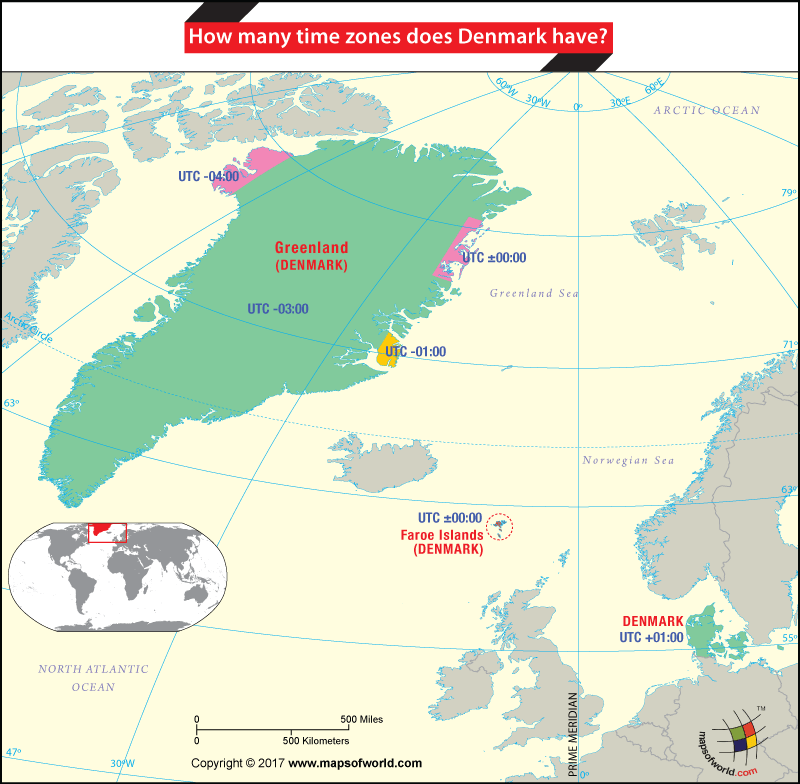Denmark Time Zone

Time Zones are always calculated by their difference to UTC, the “Universal Time Coordinated”. The Danish Realm known as the Kingdom of Denmark officially refers to the area consisting of Denmark Proper and the realm’s two autonomous constituent regions: Greenland in North America and the Faroe Islands in North Atlantic. In this article, we will explore about Time Zones in Denmark, interesting facts and more.
Time Zones in Denmark
Mainland Denmark has only one time zone, but when considering the broader Danish Realm, which includes dependencies such as Greenland and the Faroe Islands, the total number of time zones is six. Following are the six time zones of Denmark:
-
Central European Time
Denmark Proper, including cities like Copenhagen and Aarhus, adheres to this time zone. UTC+1:00 is standard time, and UTC+02:00 is daylight saving time, with transition dates following European Union rules.
-
Western European Time
The Faroe Islands adhere to this time zone. UTC+00:00 is standard time, and UTC+01:00 is daylight saving time.
-
Greenwich Mean Time
The northeast coast of Greenland has this time zone. This region uses the same time as Iceland. The UTC+-00:00 year around with no daylight saving time.
-
East Greenland Time
Ittoqqortoormiit, Nerlerit Inaat, and the surrounding area on the east coast of Greenland have this time zone. UTC-01:00 is standard time, and UTC+00:00 is daylight saving time.
-
West Greenland Time
Nuuk, Kangerlussuaq, and Qaqortoq adhere to this time zone. Tasiilaq and Kulusuk on the east coast also have this time zone. UTC-03:00 is standard time, and UTC-02:00 is daylight saving time.
-
Atlantic Time
Pituffik Space Base follows this time zone, with UTC-04:00 observed during standard time and UTC-03:00 during daylight saving time. Transition dates align with the United States rules.
Interesting Facts about Denmark Time Zone
Some interesting facts about the Denmark Time Zone are:
- There are 6 time zones associated with Denmark.
- Mainland Denmark adheres to a single time zone, Central European Time (CET), throughout most of the year. Denmark itself observes Central European Summer Time (CEST) during Daylight Saving Time.
- Faroe Islands and Greenland which are part of the Danish Realm have separate time zones. Faroe Islands have one distinct time zone and Greenland has three time zones.
- In 1980, a common time was first used in Denmark when Copenhagen local time was adopted as railway time.
- In 1983, Denmark adopted the ‘Act on the Determination of Time’ to synchronize with international time zones, aligning with Greenwich Mean Time (GMT) plus one hour.
- Greenland follows Daylight Saving Time (DST) rules, but its application varies across different regions. Except for the northeast coast, most of Greenland observes DST. The transition dates align with the rules of the European Union, commencing on the last Sunday in March and concluding on the last Sunday in October
- The Pituffik Space Base uses United States Transition Dates.
Time Difference between Major Cities of USA and Denmark
- The time difference between New York and Denmark is five hours as Denmark is UTC+1 and New York is currently at UTC-4. Denmark is five hours ahead of New York
- The time difference between Los Angeles and Denmark is eight hours as Denmark is UTC+1 and Los Angeles is currently at UTC-7. Los Angeles is eight hours behind Denmark
- The time difference between Chicago and Denmark is six hours as Denmark is UTC+1 and Chicago is currently at UTC-5. Chicago is six hours behind Denmark.
- The time difference between Houston and Denmark is six hours as Denmark is UTC+1 and Houston is currently at UTC-5. Houston is six hours behind Denmark
- The time difference between Phoenix and Denmark is 8 hours as Denmark is UTC+1 and Phoenix is currently at UTC-7. Denmark is eight hours ahead of Phoenix
- The time difference between San Diego and Denmark is eight hours as Denmark is UTC+1 and San Diego is currently at UTC-8. Denmark is eight hours ahead of San Diego.
Related Maps